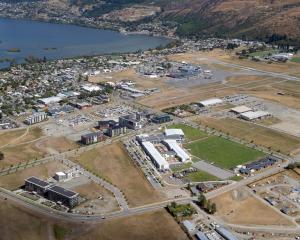The Heritage Heights body corporate and 12 unit owners have lodged the claim against five defendants - the council, joint-venture development company Sinclair Bros Building Ltd and Heritage Heights Ltd, bankrupted Sinclair Bros director Graham Sinclair and AS Major Consulting Ltd.
Seven third parties were also listed, including disgraced Invercargill engineer Tony Major, found to be largely responsible for the 2010 collapse of Stadium Southland's roof.
Yesterday, council planning and development general manager Tony Avery said ahead of the High Court hearing, scheduled for Invercargill in July, the council had contracted engineering consultants Beca to do a geotechnical assessment of the land around the apartment block, from today.
Engineers would drill between three and five holes, between 10m and 30m deep. Work was expected to be completed by April 8.
Core samples would be taken for analysis and would help inform the council's response to the claim.
‘‘As always, the council is conscious of the potential liability to ratepayers, so it is important to obtain reliable evidence about aspects of the claim that are in dispute,'' Mr Avery said.
The 43-page statement of claim lodged by the plaintiffs said the units were constructed by Sinclair Bros between February 2002 and April 2006, during which time the council carried out inspections, ultimately issuing a code of compliance.
The body corporate lists 42 defects with the apartments, largely relating to weather tightness and structural issues, and is seeking compensation from all five defendants.
Defects had resulted in ‘‘moisture ingress through the cladding and into the structure'' of the apartments, in breach of the Building Code and Building Act, requiring the owners to carry out ‘‘extensive repairs'', estimated to cost $7,082,200.
Consequential losses included rental income, cost of alternative accommodation and insurance, including increased insurance premiums, while one unit owner had suffered a loss on sale of $230,000 - ‘‘the unaffected value of $320,000 less the sale price of $90,000''.
Unit owners were also claiming general damages for ‘‘distress, anxiety, inconvenience and loss of enjoyment'', and post-remediation loss in the value of their properties, estimated to be 5% of the value.
The apartment complex was a 50-50 joint-venture development, co-owned by Sinclair Bros Building principals Graham and Stephen Sinclair and Invercargill investors Donald Erskine and his sister, Janice MacLeod.
Mountain Scene previously reported issues with the development date back to 2004 when the council put a stop-work notice on the building before successfully prosecuting Sinclair Bros and the joint venture. The brothers were prosecuted as project manager and on-site foreman and were convicted on 17 charges.
In May 2012, it was reported Heritage Heights Ltd obtained a High Court judgement against the building company and the brothers, the court ordering $750,858 in compensation, primarily for defective building work.
By September 2012, no money had been paid.
Justice Fogarty's 2012 decision said the most significant defects were a large retaining wall, ‘‘grossly inadequate weatherproofing'' of the top-row units, insufficient wall lining between units and faulty fire exits.
The building company, which was a member of the Master Builders Association, was removed from the companies register on March 17 last year.
It is one of several similar cases the council is facing, including one lodged by unit owners of the Oaks Shores Apartments, an 84-unit Frankton Rd development, last July.
As of June 30 last year, 11 building-related legal claims had been received within the district, with the council as a joined party in all of them.
In 2013, the Otago Daily Times reported the council had been involved in 18 weathertightness claims, including 14 resulting in a council payout.
The council's share of settlement costs at that time totalled $3.28 million, rising to $3.6 million when legal costs were included with potential exposure from other unresolved claims totalling another $10.9 million.
The council did not have any remaining insurance cover for those claims and no financial provision in its long-term plan to meet any claims.
That meant any court-ordered payout would come from ratepayers - every $1 million paid out would average $45 per rateable property.
Mr Avery said the council was targeted because it was ‘‘often the last entity standing despite who built it''.












